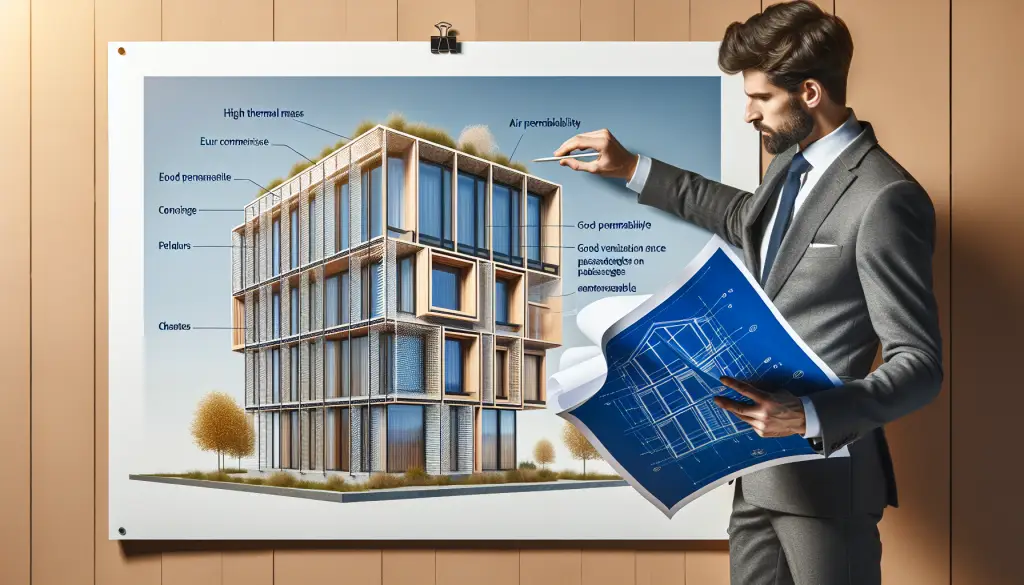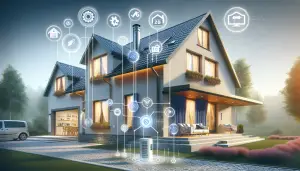Understanding Thermal Mass
Thermal mass refers to the ability of a material to absorb, store, and later release thermal energy. In building design, materials with high thermal mass can help to maintain consistent internal temperatures by absorbing excess heat during the day and releasing it during cooler periods, such as overnight. This makes buildings more energy-efficient and comfortable for occupants.
Common Materials with High Thermal Mass
- Concrete
- Brick
- Stone
- Tile
- Water
The Importance of Air Permeability and Thermal Mass
Air permeability measures how easily air can pass through the building envelope. Properly balancing air permeability and thermal mass is crucial for optimising building performance. An airtight building with high thermal mass can maintain steady internal temperatures and reduce energy consumption, leading to lower utility bills and a smaller carbon footprint.
Advantages of Optimising Air Permeability and Thermal Mass
- Reduced energy consumption
- Enhanced occupant comfort
- Lowered greenhouse gas emissions
- Extended lifespan of heating and cooling systems
Strategies for Balancing Air Permeability and Thermal Mass
Optimising air permeability and thermal mass involves a multifaceted approach. Here are a few strategies suggested by Ratio Seven:
Ensure Proper Insulation
High-quality insulation reduces unwanted air leakage and complements the effects of thermal mass, ensuring that stored thermal energy is not lost. Materials like wool, cellulose, and rigid foam are excellent choices for insulation.
Use of Thermal Mass Materials
Incorporate materials like concrete, brick, or tile in the building’s design to maximise thermal mass. These materials help stabilise indoor temperatures by storing and releasing heat as needed.
Seal Air Leaks
Identify and seal any air leaks in the building envelope. Common areas to check include windows, doors, and around electrical outlets. Consider using draft stoppers and weatherstripping for added protection.
Mechanical Ventilation
Employ mechanical ventilation systems to control air permeability without compromising on indoor air quality. These systems can be particularly beneficial in buildings that are sealed for thermal mass optimisation.

Case Study: Ratio Seven Building Projects
Ratio Seven has worked on numerous projects where balancing air permeability and thermal mass has significantly improved building performance. One notable project involved a residential building where advanced insulation and a combination of high thermal mass materials were used. The result was a drastic reduction in energy consumption and enhanced comfort for the residents.
Key Strategies Implemented
- High-quality insulation
- Use of concrete and brick materials
- Advanced sealing techniques
- Implementation of mechanical ventilation
Thermal Mass Summary
Balancing air permeability and thermal mass is essential for optimising building performance. Properly managed, these factors can lead to reduced energy consumption, increased comfort, and lower environmental impact. Ratio Seven specialises in implementing these strategies, ensuring that buildings are both energy-efficient and comfortable for occupants.
Frequently Asked Questions (FAQs)
What is thermal mass and why is it important?
Thermal mass refers to the ability of a material to absorb, store, and later release thermal energy. It is crucial in building design for stabilising indoor temperatures and enhancing energy efficiency, thereby reducing heating and cooling costs.
How does air permeability affect building performance?
Air permeability measures how easily air can pass through a building envelope. Properly managing it is essential for minimizing energy loss and ensuring indoor comfort. If not controlled, it can lead to higher energy costs and reduced effectiveness of thermal mass.
Can I improve my building’s thermal mass without major renovations?
Yes, there are several ways to enhance thermal mass without major renovations. You can add thermal mass internally using elements like water containers, heavy curtains, or additional interior walls of brick or stone. Sealing air leaks and improving insulation are also effective strategies.
Is mechanical ventilation necessary?
While not always necessary, mechanical ventilation can significantly enhance the control over air permeability. It is especially useful in buildings that are highly sealed for thermal mass optimisation, ensuring good indoor air quality without compromising energy efficiency.
What kind of projects has Ratio Seven worked on?
Ratio Seven has been involved in various projects focusing on optimising air permeability and thermal mass. Notable projects include residential buildings where advanced insulation and high thermal mass materials were used to achieve significant energy savings and improved comfort levels.




